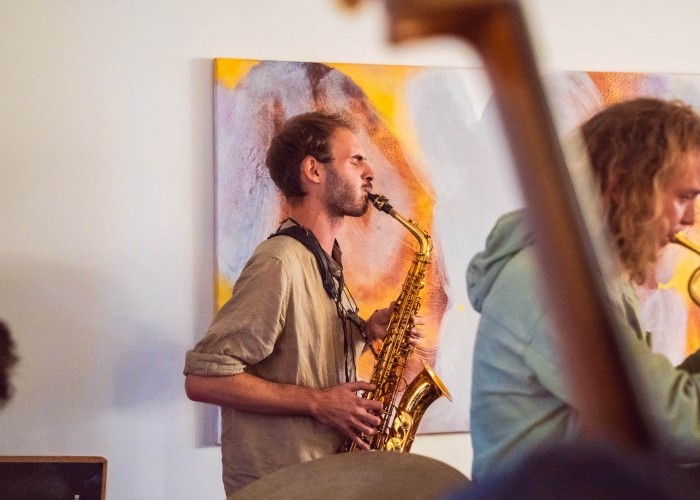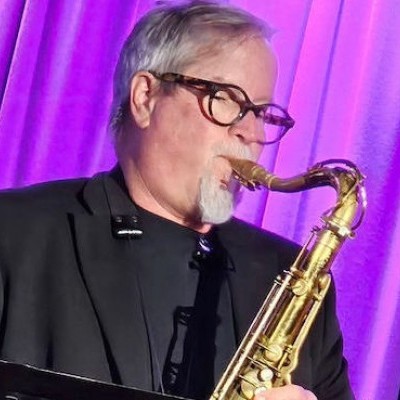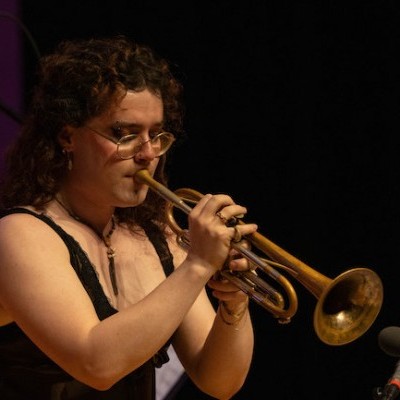Oct 28, 2025 10:47 AM
In Memoriam: Jack DeJohnette, 1942–2025
Jack DeJohnette, a bold and resourceful drummer and NEA Jazz Master who forged a unique vocabulary on the kit over his…

Saxophonist Luka Zabric and trumpeter Kuba Kurek perform during the 21st edition of Jazztopad.
(Photo: Karol Adam Sokolowski)Wrocław is not one of Poland’s more popular tourist destinations. But it’s a historically important city, one of its annual highlights being a sprawling Christmas Market. This usually opens during the Jazztopad festival (which puns on Listopad, the Polish word for November), but this year they must have heard about our improvising invasion, as the market’s debut was cautiously delayed until post-festival time. This was the 21st edition of Jazztopad, so it’s now part of the tradition, even while retaining strong streaks of adventure into free-jazz and moderne composition team-ups. Jazztopad also exists in an annual summer NYC-form, bringing its concepts across the Atlantic, spread around a selection of key venues.
The 10-day Wrocław feast, which ran Nov. 15–24, is divided into large-scale concerts in the architecturally looming NFM (National Forum of Music), where Jazztopad is created, but it also sends tendrils out into private homes for its afternoon Living Room Concerts, as well as venturing down into the basement of the nearby Mleczarnia, a bar and café for denizens of the deep night. In the NFM, there are also a pair of smaller spaces to complement its main concert hall. All atmospheres are covered.
Artistic director Piotr Turkiewicz has a very firm vision of the festival strategy, with these ongoing musical strands appearing each year. A key feature is the presence of collaborative premieres with the new music ensembles of the NFM, its Philharmonic orchestra and the Lutosławski Quartet. On opening night, the Los Angeles-born drummer Denardo Coleman (in golden olive suit) presented an interpretation of his father Ornette’s 1959 album The Shape Of Jazz To Come, with a band that included trumpeter Ambrose Akinmusire, saxophonist Isaiah Collier, pianist Craig Taborn, bassist Brad Jones and incongruous guitarist Jakob Bro, along with the NFM Philharmonic. The collective creation didn’t actually sound much like the original album, aside from the unavoidably distinctive “Lonely Woman,” but Ornette would probably have enjoyed such a diversion.
The orchestra provided lavish nestling colorations, but the wiry squirming was largely left to Akinmusire and Collier, their soloing operating at a less energized level when compared to the heights found within their own bands. Abstract trumpet flurries blew into group free-playing, alternating with tonal embellishments from the NFM ranks, where cyclic horn figures flourished in the orchestral lagoon. Ethereal gloom and morbidity were present in the busy clarinet foregrounding, dark oboe also creeping forth, vibraphone scampering. Coleman set up a strong pulse, with a George Russell aura, as Bro’s guitar sounded like a tired synth.
Down in that Mleczarnia basement den, the ever-inspiring Sundogs trio led the nightly improvising sessions. It was here that Collier truly flared up, sitting at the drums, with Mateusz Rybicki on bass clarinet, over the slow bounce of stuttering traps. Collier loaded snare and cymbals with a rattlesnake attack. Then he hoisted his tenor for a rabid cross-pollination with Rybicki’s clarinet, before he too chose tenor for some hyperactive low-toned interaction. In the end, the piece almost became like unto Terry Riley’s “In C,” as Taborn, Akinmusire and Jones also came onstage. Such are the heady pleasures and soft meditations of a 1 a.m. “jam” set. The other two masterful Sundogs are Zbigniew Kozera (bass/guimbri) and Samuel Hall (an Australian drummer living in Berlin). The excellent cast of Polish players included trumpeter Kuba Kurek and saxophonist Matylda Gerber, the latter bringing her alto instead of baritone, opening up a whole new area of her style. Newcomer local violinist Julia Stein was ubiquitous, varied and highly engaged.
The Stateside presence continued a week later with the fast-ascending poet Aja Monet and her jazzed-up trio, playing on the “reversed stage” of the main hall. Even though active for some time, Monet’s collaborative work with musicians has arrived quite recently. Although adopting a “mysterious” mien, complete with shades and insularity, she periodically fills herself with outgoing humor during her poem-song introductions, communicating with the audience in a different fashion. Although most of her poems dissect serious matters, Monet presents them with a knowing sense of multiple layering.
The players stuck to a fairly straight jazz backing, not intending to distract from the words, which were always clearly audible. Even native English-language speakers need to listen carefully to Monet’s limber flow, so this would have been even more demanding for the Polish locals, despite their typically high English-speaking standards. “Weathering” had keyboardist Javier Santiago playing trumpet with one hand, and then Monet suggested that we can “shame the devil” during “The Devil You Know.”
Once again, Jazztopad’s satellite situations revealed players in a different light, where Santiago, Micah Collier (bass) and Justin Brown (drums) delivered more riled-up free-form expressions, uninhibited by their word-supporting roles. This was particularly evident during the Living Room apartment sessions.
Jumping back to the first weekend, The Necks also played on the reversed-stage, this veteran Australian improvising trio accustomed to approaching from a stance of repetition, enhancement and gradual development. Their only other soft-rule is that each set flows for around one hour. They don’t know where they’re heading, but they do know the approximate duration. A gentle faintness slipped forth, with light mallet-touches on the drums, dapples of watercolor piano and a slowly pivoting bowed bass. Reflective and mournful, with a vaguely South African feel to the piano, the melody of the first set turned into a pulse, the bass making soft scything strokes, stick and brushwork increasing the shimmer. The second set was even better, with a Moondog medieval lilt to the piano, along with twitchy hand-drumming with recurrent shaker. A firm bass core gathered the threesome closer, under an intense blue light.
The intimate interactions continued throughout the week down in Mleczarnia with Luka Zabric & The Gatherers, a new find from Slovenia. Zabric is a careful, precise technician on alto saxophone, sourcing a deep well of personalized expression, maintaining a high, clear purity during his incremental investigations, more Lee Konitz than Isaiah Collier, almost never upping the curve to explosive. Subtle unified group pronouncements uncoiled, rising up from a sparse palette, with sensitized pocket trumpet, bass and drums, eventually peaking with a lightly romping tune well suited to a wedding held in an alleyway. Always inquiring, Zabric further revealed his abilities for hyper-aware collaboration over the coming days, in the apartments and the basement. We will be hearing more of his work, as his global significance will certainly grow.
Sun-Mi Hong & Alistair Payne played a mostly improvised set in Mleczarnia the following day. This percussionist-and-trumpeter pair hail from South Korea and Scotland, but arrived from Amsterdam. The stark exposure and initial simplicity opened up a wild ride through multiple phases, as Payne vocalized through his horn and Sun-Mi rambled hard, a dusty emission here, a well-landed mallet there. The deep bass drum was rationed out, as Payne introduced Monk-snatches, which turned into a buzzed ambient drone section. Sun-Mi clattered metal to the floor, going into a more condensed jazz zone. Following this set, the “jam” opened with Mat Maneri on aggressively exciting amped viola, as the Monet bass-drums team jumped up, going for a gritty and Herculean style. Then came Kris Davis on keyboards, Sundog Rybicki on clarinet and Payne returning for an uppity solo.
One more night downstairs, we had the North American invasion of François Houle (clarinet) and Gordon Grdina (acoustic guitar and oud), jousting lightly at length, revealing a tensed, diaphanous nature, highly worked out in its capering flow.
There was so much more happening besides, with engaging sets from Saagara (a dynamic Polish-Indian electro-Carnatic fusion group), Linda Fredriksson’s Juniper (Finland), Michael Bates and Kris Davis each playing with the Lutosławski Quartet, Maneri with the French bassist Sarah Murcia, and Melting Pot, a mixed-countries improvising group freshly assembled each year for a mini tour around the selecting clubs and festivals. Jazztopad retains massive energies of creativity, sometimes from noon until as late as 5 a.m., providing the supreme example of sustained excitement or reflection. DB

Jack DeJohnette boasted a musical resume that was as long as it was fearsome.
Oct 28, 2025 10:47 AM
Jack DeJohnette, a bold and resourceful drummer and NEA Jazz Master who forged a unique vocabulary on the kit over his…

“I’ve told students, ‘I don’t mind if you use AI for this or that project,’” says MIT’s Pascal Le Boeuf. “‘But you need to tell me.’”
Sep 18, 2025 11:14 AM
A standard joke when it comes to discussing artificial intelligence, or AI, is that it’s developing so rapidly that…

Chuck Manning Works for NASA … and plays jazz.
Sep 18, 2025 11:23 AM
Congratulations! After years of study, you’ve earned your degree in jazz performance. But let’s face it: Making a…

Always a sharp dresser, Farnsworth wears a pocket square given to him by trumpeter Art Farmer. “You need to look good if you want to hang around me,” Farmer told him.
Sep 23, 2025 11:12 AM
When he was 12 years old, the hard-swinging veteran drummer Joe Farnsworth had a fateful encounter with his idol Max…

“Make time and energy to meet people and make friends,” suggests Millie Ahearn, a student at DePaul University.
Sep 18, 2025 11:32 AM
For many students, the transition into a collegiate jazz program can feel overwhelming — new peers, unfamiliar…